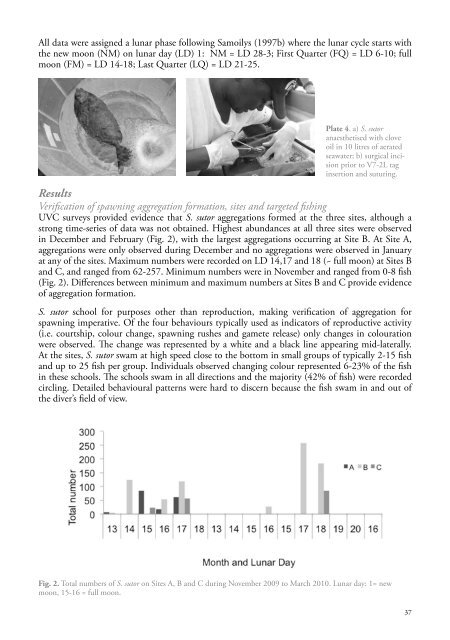WIOMSA-CORDIO spawning book Full Doc 10 oct 13.pdf
WIOMSA-CORDIO spawning book Full Doc 10 oct 13.pdf
WIOMSA-CORDIO spawning book Full Doc 10 oct 13.pdf
You also want an ePaper? Increase the reach of your titles
YUMPU automatically turns print PDFs into web optimized ePapers that Google loves.
All data were assigned a lunar phase following Samoilys (1997b) where the lunar cycle starts withthe new moon (NM) on lunar day (LD) 1: NM = LD 28-3; First Quarter (FQ) = LD 6-<strong>10</strong>; fullmoon (FM) = LD 14-18; Last Quarter (LQ) = LD 21-25.Plate 4. a) S. sutoranaesthetised with cloveoil in <strong>10</strong> litres of aeratedseawater; b) surgical incisionprior to V7-2L taginsertion and suturing.ResultsVerification of <strong>spawning</strong> aggregation formation, sites and targeted fishingUVC surveys provided evidence that S. sutor aggregations formed at the three sites, although astrong time-series of data was not obtained. Highest abundances at all three sites were observedin December and February (Fig. 2), with the largest aggregations occurring at Site B. At Site A,aggregations were only observed during December and no aggregations were observed in Januaryat any of the sites. Maximum numbers were recorded on LD 14,17 and 18 (~ full moon) at Sites Band C, and ranged from 62-257. Minimum numbers were in November and ranged from 0-8 fish(Fig. 2). Differences between minimum and maximum numbers at Sites B and C provide evidenceof aggregation formation.S. sutor school for purposes other than reproduction, making verification of aggregation for<strong>spawning</strong> imperative. Of the four behaviours typically used as indicators of reproductive activity(i.e. courtship, colour change, <strong>spawning</strong> rushes and gamete release) only changes in colourationwere observed. The change was represented by a white and a black line appearing mid-laterally.At the sites, S. sutor swam at high speed close to the bottom in small groups of typically 2-15 fishand up to 25 fish per group. Individuals observed changing colour represented 6-23% of the fishin these schools. The schools swam in all directions and the majority (42% of fish) were recordedcircling. Detailed behavioural patterns were hard to discern because the fish swam in and out ofthe diver’s field of view.Fig. 2. Total numbers of S. sutor on Sites A, B and C during November 2009 to March 20<strong>10</strong>. Lunar day: 1= newmoon, 15-16 = full moon.37


















